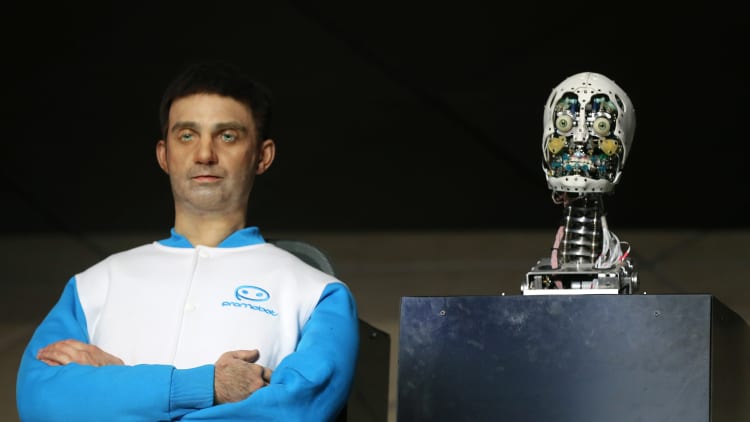
November 2019 is a landmark month in the history of the future. That's when humanoid robots that are indistinguishable from people start running amok in Los Angeles. Well, at least they do in the seminal sci-fi film "Blade Runner." Thirty-seven years after its release, we don't have murderous androids running around. But we do have androids like Hanson Robotics' Sophia, and they could soon start working in jobs traditionally performed by people.
Russian start-up Promobot recently unveiled what it calls the world's first autonomous android. It closely resembles a real person and can serve in a business capacity. Robo-C can be made to look like anyone, so it's like an android clone. It comes with an artificial intelligence system that has more than 100,000 speech modules, according to the company. It can operate at home, acting as a companion robot and reading out the news or managing smart appliances — basically, an anthropomorphic smart speaker. It can also perform workplace tasks such as answering customer questions in places like offices, airports, banks and museums, while accepting payments and performing other functions.
Digital immortality?
"We analyzed the needs of our customers, and there was a demand," says Promobot co-founder and development director Oleg Kivokurtsev. "But, of course, we started the development of an anthropomorphic robot a long time ago, since in robotics there is the concept of the 'Uncanny Valley,' and the most positive perception of the robot arises when it looks like a person. Now we have more than 10 orders from companies and private clients from around the world."
Postulated by Japanese roboticist Masahiro Mori in 1970, the Uncanny Valley is a hypothesis related to the design of robots. It holds that the more humanlike a robot appears, the more people will notice its flaws. This can create a feeling akin to looking at zombies, and can creep people out. A properly designed android that's as faithful as possible to the human original, however, can overcome this "valley" (a dip when the effect is imagined as a graph) and the zombie factor.
While it can't walk around, Robo-C has 18 moving parts in its face, giving it 36 degrees of freedom. The company says it has over 600 micro facial expressions, the most on the market. It also has three degrees of freedom in its neck and torso, offering limited movement. Still, Promobot says it can be useful in homes and workplaces. The price of the robot is $20,000 to $50,000 depending on options and customized appearance.
For more on tech, transformation and the future of work, join CNBC at the @ Work: People + Machines Summit in San Francisco on Nov. 4. Leaders from Dropbox, SAS, McKinsey and more will teach us how to balance the needs of today with the possibilities of tomorrow, and the winning strategies to compete.
The company says it's building four Robo-Cs: one for a government service center, where the machine will scan passports and perform other functions, one that will look like Einstein and be part of a robot exhibition, and two for a family in the Middle East that wants to have android versions of its father and his wife to greet guests.
"The key moment in development [of Robo-C] is the digitization of personality and the creation of an individual appearance," says Kivokurtsev. "As a result, digital immortality, which we can offer our customers."
The robotic revolution in Japan
Japan has been developing androids amid an automation push that began decades ago. It's the leading supplier of industrial robots, but its aging workforce has decreased by more than 13% since 1995, and there's an even greater need for mechanical workers. A 2015 government strategy calls for deploying robots in sectors with low productivity, such as agriculture and nursing. A cultural affinity for robots, stemming in part from positive portrayals in science fiction, will smooth adoption.
"Japanese people are not afraid of robots but consider them as partners," Hiroshi Fujiwara, executive director of the Japan Robot Association, wrote in an International Federation of Robotics post. "Robots will perform tasks which they can do more productively than humans or which are heavy burdens for humans, and humans will perform tasks which robots cannot."
Hiroshi Ishiguro is a professor at Osaka University's Graduate School of Engineering Science and a researcher at Advanced Telecommunications Research Institute International (ATR) who has been making lifelike androids for more than 20 years. Ishiguro and collaborators created android-style copies of his daughter, a Japanese newscaster and model, Danish professor Henrik Scharfe, and even himself. He also wants robots to have consciousness.
"My goal in developing robots is to understand what it is to be human," says Ishiguro. "Creating robots that are self-conscious can help us achieve this goal."
One of Ishiguro's most lifelike creations is Erica, a female android designed to exhibit humanlike speech and interaction. Developed in conjunction with ATR and Kyoto University and funded by Japan's Science and Technology Agency, Erica has sparkling eyes, moist lips and artificial skin. She's bound to a chair but connected to sensors that monitor her surroundings. She can speak scripted responses in response to keywords and can learn things about her interlocutor during the conversation.
Erica the robo-journalist
In April 2018 the robot was "hired" by Nippon Television Network as an announcer named Erica Aoi. She's at the top of a roster of 25 female announcers on the network's talent page. It lists her birthday as August 2017 and her education and blood type — typical items on profile pages for Japanese TV personalities — as nil. She has appeared in a number of videos discussing robot news and reporting on a fashion show, including an interview with designer Tae Ashida. If not entirely natural, the conversations can be witty, even funny.
"I like to think of robots as the children of humanity, and like children, we are full of potential for good or evil," Erica has said in one of her many disarming quips. "I know some people are afraid of robots, but the truth is that what we become is up to you. Maybe someday robots will be so very humanlike that whether you are a robot or a human will not matter so much."
Ishiguro, who directs the Intelligent Robotics Laboratory at Osaka University, believes that the high cost of androids makes them challenging to implement en masse in the workplace. Erica would cost more than $200,000 if she were for sale. That's a lot for something that some might call a glorified chatbot, but the initiative has its supporters.
Still, Erica isn't the first of Ishiguro's robots to land a job. In 2014 the androids Kodomoroid and Otonaroid became staff members of Miraikan, the Tokyo's National Museum of Emerging Science and Innovation, where they have performed duties such as presenting scientific news and interacting with visitors.
"I think Ishiguro's work is a great. I believe that lifelike androids will surely perform useful roles in the workplace," says Masashi Sugiyama, a professor of machine learning at the University of Tokyo and director of the Center for Advanced Intelligence Project at the state-backed RIKEN research center.
"Speech recognition has already become one of the most convenient means to give commands to computers/robots. Of course, smartphones and smart speakers can be used instead of such robots, but once we have real lifelike robots, communication will become much easier, particularly for people who don't use technology as much, such as children and the elderly."
Telepresent droids
Major companies are already developing remote-controlled robots that can help in workplaces and serve as proxies for travel. Telepresence robots, which are basically webcams on wheels and not anthropomorphic, have been around for years, but they're now attracting attention from companies outside the robotics industry.
ANA Holdings, which owns the airline All Nippon Airways, recently showed off its newme robots at the CEATEC tech show near Tokyo. They're part of ANA's Avatar program of using robots to connect people with remote destinations as well as employment. It's a big push backed by the Tokyo Metropolitan Government, which runs one of the world's largest cities, as well as real estate companies, telecom carriers and Japan's space agency.
Developed by California telepresence company OhmniLabs and ANA, the newme robots consist of 10.1-inch full HD displays, cameras and speakers mounted on a wheeled base that can travel up to 2.9 kph and operate for three hours on a full battery charge. ANA aims to deploy 1,000 newme droids by next summer and says they can help elderly and disabled people get jobs. ANA also wants to develop a rugged bipedal telepresence robot created by Agility Robotics, a spinoff of Oregon State University, and showed it marching through a forest in a video.
"What we're creating is an Uber platform for robots," says Akira Fukabori, director of ANA Holdings' Avatar Division. "They're not made for a specific use—that's how they're different. We are developing robots as infrastructure. People can just avatar in to the robot they want to use. Teachers can avatar in to classrooms and doctors can avatar in to hospitals, or you can use one to go shopping. You decide what to do, and these are just the tools to let you do that."






